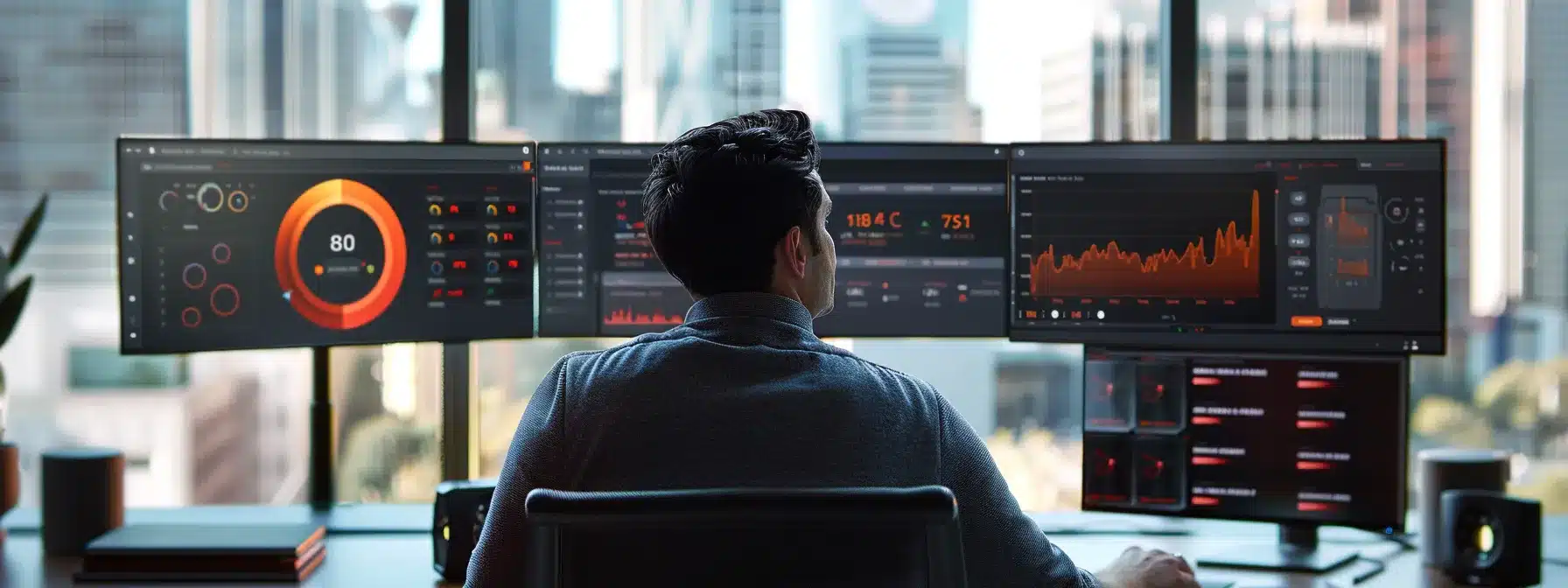
How a CMMC Consultant Can Uncover Gaps in Your Cybersecurity Practices Effectively
In today’s world, many businesses struggle to maintain effective cybersecurity practices, often leaving them vulnerable to attacks. A CMMC consultant can identify gaps in these practices, helping organizations strengthen their security posture. This article will cover how consultants perform in-depth assessments, analyze CMMC domains, and utilize specialized tools to uncover deficiencies. By engaging with this content, readers will learn how to address their specific cybersecurity concerns effectively and gain actionable insights to improve their overall security strategy.
Understanding the CMMC Consultant’s Role in Gap Identification

CMMC consultants play a crucial role in identifying gaps in cybersecurity practices by defining the scope of CMMC assessment needs tailored to each business. They apply their extensive knowledge of the CMMC framework alongside expertise in encryption and firewall management. Consultants also ensure alignment with business contexts, setting clear expectations for the gap analysis process, which is essential for effective CMMC compliance consulting and outsourcing strategies.
Defining the Scope of Your CMMC Assessment Needs
Defining the scope of your CMMC assessment needs is essential for a comprehensive risk assessment that aligns with the cybersecurity maturity model certification requirements. A cmmc consultant identifies specific areas where a business may fall short of compliance regulations, including those related to FedRAMP standards. By clearly outlining the assessment parameters, organizations can better prepare for their certification journey, ensuring that they address potential vulnerabilities proactively.
How Consultants Apply CMMC Framework Knowledge
CMMC consultants utilize their in-depth understanding of CMMC compliance requirements to assess a business’s current cybersecurity posture systematically. By analyzing access control measures, they identify weaknesses that could be exploited by advanced persistent threats. Furthermore, consultants evaluate the security of assets and subcontractor practices, ensuring that all layers of the organization are fortified against potential vulnerabilities.
Aligning Consultant Expertise With Your Business Context
Aligning a CMMC consultant’s expertise with a business’s unique context is essential for effective gap identification in cybersecurity practices. By understanding how controlled unclassified information flows through an organization’s infrastructure, consultants can tailor their methodologies to highlight specific risks. This alignment ensures that the cybersecurity culture within the organization is considered, ultimately leading to improvements that resonate across all levels of the business.
Setting Expectations for the Gap Analysis Process
Setting clear expectations for the gap analysis process is essential for organizations seeking to comply with CMMC requirements. By outlining the specific steps involved and the role of risk management, a CMMC consultant ensures that businesses understand the importance of maintaining cybersecurity hygiene throughout their system. This transparency not only facilitates a more effective evaluation but also establishes a foundation based on the guidelines set forth by the National Institute of Standards and Technology, ultimately leading to a more robust cybersecurity posture.
Performing in-Depth Cybersecurity Posture Assessments

Reviewing existing security policies and procedures provides a foundational step for assessing an organization’s cybersecurity posture. Consultants map current practices against CMMC requirements, analyze network architecture and security controls, evaluate data protection mechanisms for controlled unclassified information (CUI), and assess physical security measures. These evaluations not only ensure compliance but also contribute to a competitive advantage through effective automation and implementation strategies, particularly in cloud computing environments.
Reviewing Existing Security Policies and Procedures
Reviewing existing security policies and procedures is a fundamental step in uncovering gaps within a business’s cybersecurity practices. By ensuring transparency in how these policies align with the cybersecurity maturity model, a CMMC consultant can identify areas that may not comply with the CMMC final rule. This understanding allows organizations to enhance their computer network defenses, effectively mitigating risks and ensuring the protection of sensitive information.
Mapping Current Practices Against CMMC Requirements
Mapping current practices against CMMC requirements is essential for organizations in the defense industrial base to ensure robust cybersecurity measures. A CMMC consultant examines critical areas, such as mobile device management and file sharing protocols, to identify potential vulnerabilities that could lead to a data breach. By aligning existing policies with specific compliance standards, businesses can better protect sensitive information associated with government contracts, fostering a stronger security posture throughout their operations.
Analyzing Network Architecture and Security Controls
Analyzing network architecture and security controls is a critical component of the CMMC assessment process, where a CMMC consultant meticulously examines the cybersecurity landscape within an organization. By evaluating user access management, data flow, and the overall strategy implemented to protect information, the consultant identifies vulnerabilities that could potentially lead to non-compliance with the CMMC framework. This targeted analysis not only reveals gaps but also provides insights for strengthening defenses against cyber threats, ensuring organizations remain resilient and compliant in today’s complex environment.
Evaluating Data Protection Mechanisms for CUI
Evaluating data protection mechanisms for Controlled Unclassified Information (CUI) is a pivotal aspect of the CMMC model assessment process. A CMMC expert meticulously analyzes existing security protocols, ensuring they align with compliance requirements and effectively safeguard sensitive information. This thorough audit not only enhances an organization’s cybersecurity reputation but also bolsters stakeholder confidence in their protective measures, ultimately mitigating risks associated with unauthorized access or data breaches.
Assessing Physical Security Measures
Assessing physical security measures is a vital component of any CMMC assessment, as it addresses the integrity of an organization’s infrastructure. A CMMC consultant meticulously evaluates access controls, surveillance systems, and environmental protections to identify potential weaknesses that could expose sensitive information. By integrating insights from configuration management practices and conducting thorough internal audits, consultants help businesses fortify their physical defenses while ensuring compliance with established cybersecurity requirements, directly enhancing their overall security posture.
Identifying Deficiencies Through CMMC Domain Analysis

A CMMC consultant conducts a thorough evaluation of an organization’s cybersecurity practices by examining access control implementation weaknesses and pinpointing gaps in audit and accountability logs. They also check the readiness of incident response plans, assess risk management process shortfalls, and verify the effectiveness of security awareness training. This comprehensive analysis, leveraging knowledge from managed security services, identifies critical deficiencies that organizations must address to achieve compliance and enhance their security posture.
Examining Access Control Implementation Weaknesses
Examining access control implementation weaknesses is vital for organizations striving to meet CMMC standards, particularly those involved in federal acquisitions. A consultant analyzes how access privileges are granted and managed, identifying gaps that may violate compliance regulations. By ensuring robust access controls align with CMMC certification requirements, organizations can proactively enhance their cybersecurity posture and protect sensitive information from unauthorized access.
Pinpointing Gaps in Audit and Accountability Logs
Pinpointing gaps in audit and accountability logs is essential for organizations striving to enhance their information security posture. A CMMC consultant examines the logs to ensure proper authentication measures are in place, identifying areas where documentation may be lacking or insufficient. This due diligence helps organizations navigate the complexity of compliance requirements, revealing vulnerabilities that, if unaddressed, could jeopardize their CMMC audit readiness and overall cybersecurity effectiveness.
Checking Incident Response Plan Readiness
Checking the readiness of an incident response plan is essential for organizations aiming to achieve CMMC compliance. A CMMC consultant evaluates existing incident response strategies, ensuring resources are adequately allocated for effective threat management throughout the supply chain. By identifying potential weaknesses in the response protocols, businesses can bolster their defenses against cyber incidents, safeguarding sensitive information and maintaining regulatory standards.
Assessing Risk Management Process Shortfalls
Assessing risk management process shortfalls is a critical task for CMMC consultants aiming to bolster an organization’s cybersecurity framework. By closely examining the procedures in place for identifying, evaluating, and mitigating risks, consultants can identify weak points that leave businesses vulnerable to threats. Implementing robust risk management strategies not only enhances compliance with CMMC requirements but also ensures that organizations are well-prepared to respond to potential cybersecurity incidents effectively.
Verifying Security Awareness Training Effectiveness
Verifying the effectiveness of security awareness training is essential for organizations seeking to bolster their cybersecurity posture under CMMC guidelines. A CMMC consultant thoroughly assesses training programs to ensure that employees are equipped with the knowledge required to recognize and respond to potential threats. By implementing hands-on simulations and evaluating response metrics, organizations can identify areas for improvement, ensuring that staff members remain vigilant and committed to maintaining a secure environment.
Utilizing Specialized Tools and Techniques for Detection

CMMC consultants leverage specialized tools and techniques to uncover cybersecurity gaps effectively. They employ vulnerability scanning technologies to identify weaknesses, conduct penetration testing exercises to simulate cyberattacks, and use configuration auditing software for compliance verification. Additionally, analyzing Security Information and Event Management (SIEM) data provides insights into potential security incidents, enhancing an organization’s overall readiness and resilience against threats.
Employing Vulnerability Scanning Technologies
Employing vulnerability scanning technologies is a critical step for organizations working with CMMC consultants to enhance their cybersecurity practices. By systematically identifying weaknesses in networks and systems, these technologies provide insights that are vital for understanding potential risks. A CMMC consultant can utilize these scans to address vulnerabilities before they are exploited, ensuring compliance with CMMC requirements and ultimately protecting sensitive information from cyber threats.
Conducting Penetration Testing Exercises
Conducting penetration testing exercises is a vital component in identifying and addressing vulnerabilities within an organization’s cybersecurity framework. A CMMC consultant systematically simulates cyberattacks to evaluate defenses, revealing weaknesses that could be exploited by malicious actors. This proactive approach not only enhances compliance with CMMC standards but also equips businesses with essential insights to fortify their security measures effectively.
Using Configuration Auditing Software
Using configuration auditing software allows CMMC consultants to analyze an organization’s systems and processes for alignment with regulatory requirements. This software systematically examines configurations, detecting any deviations that could lead to security vulnerabilities. By addressing these gaps, businesses can enhance their compliance posture and better protect sensitive information from potential threats.
Analyzing Security Information and Event Management SIEM Data
Analyzing Security Information and Event Management (SIEM) data is essential for identifying potential cybersecurity gaps within an organization. CMMC consultants harness SIEM tools to consolidate and monitor security event logs, providing real-time insights into suspicious activities. By evaluating these data streams, they can pinpoint anomalies that indicate vulnerabilities, thereby reinforcing compliance with CMMC standards and enhancing overall security measures.
Analyzing Documentation and Evidence Collection

Thorough analysis of documentation and evidence collection is essential for identifying cybersecurity gaps. This involves reviewing System Security Plans (SSP) to ensure compliance, examining Plans of Action & Milestones (POAM) for unaddressed deficiencies, verifying evidence of implemented controls, and spotting inconsistencies in compliance documentation. Each of these areas provides insights vital for enhancing an organization’s cybersecurity posture.
Reviewing System Security Plans SSP Thoroughly
Thoroughly reviewing System Security Plans (SSP) is essential for identifying potential gaps in a business’s cybersecurity practices. A CMMC consultant analyzes these documents to ensure they align with both CMMC compliance requirements and the organization’s operational context. By scrutinizing the SSP, consultants can pinpoint areas lacking robust security controls, ultimately guiding organizations in strengthening their defenses and safeguarding sensitive information.
Examining Plans of Action & Milestones POAM
Examining Plans of Action & Milestones (POAM) is an essential step for CMMC consultants tasked with identifying gaps in cybersecurity practices. These documents outline how an organization plans to address known deficiencies and track progress toward compliance. By evaluating the POAM, consultants can uncover unaddressed deficiencies that could hinder an organization’s path to CMMC certification, allowing businesses to take proactive measures to enhance their security posture effectively.
Verifying Evidence of Implemented Controls
Verifying evidence of implemented controls is critical for assessing an organization’s cybersecurity effectiveness during a CMMC evaluation. A CMMC consultant meticulously examines relevant documentation, such as security control assessments and compliance checklists, to ensure that established protocols are not only documented but actively functioning. This process helps organizations identify discrepancies between documented security measures and their actual implementation, ensuring that any gaps are promptly addressed to maintain compliance with CMMC standards.
Spotting Inconsistencies in Compliance Documentation
Spotting inconsistencies in compliance documentation is vital for businesses aiming to meet CMMC standards. A CMMC consultant reviews various documents, such as security control assessments and compliance checklists, to identify discrepancies between documented processes and their actual execution. This careful examination helps organizations address vulnerabilities that could impede their certification journey and reinforces a well-structured cybersecurity framework.
Delivering Actionable Reports and Remediation Roadmaps

CMMC consultants deliver actionable reports that present clear findings on identified security gaps, prioritizing vulnerabilities based on their impact on CMMC compliance. They recommend specific steps for organizations to close these security deficiencies and outline a strategic path toward CMMC compliance readiness. This structured approach ensures organizations focus on critical areas, enhancing their overall cybersecurity posture.
Presenting Clear Findings on Identified Security Gaps
Presenting clear findings on identified security gaps is crucial in the CMMC compliance journey. A CMMC consultant systematically organizes the results of their assessments, detailing vulnerabilities that could impact an organization’s compliance status. By effectively communicating these findings, consultants empower businesses to understand their weaknesses and prioritize remediation efforts, ultimately guiding them toward a strong cybersecurity posture and ensuring readiness for certification.
Prioritizing Vulnerabilities Based on CMMC Impact
Prioritizing vulnerabilities based on their impact on CMMC compliance is crucial for organizations aiming to strengthen their cybersecurity posture. A CMMC consultant evaluates each identified gap to determine its potential consequences on compliance status, helping businesses focus resources on fixing the most critical issues first. This targeted approach not only aids in expediting the certification process but also ensures that organizations effectively mitigate risks associated with non-compliance.
Recommending Specific Steps for Closing Security Deficiencies
A CMMC consultant provides precise recommendations for organizations to effectively close identified security deficiencies. By prioritizing these steps based on the potential impact on compliance, consultants guide businesses to implement enhanced access controls, refine incident response plans, and bolster employee training programs. This targeted approach not only facilitates faster compliance with CMMC standards but also significantly strengthens the overall cybersecurity posture, protecting sensitive information from emerging threats.
Outlining a Strategic Path Toward CMMC Compliance Readiness
To outline a strategic path toward CMMC compliance readiness, a CMMC consultant develops detailed action plans that align with an organization’s specific needs. This involves identifying key areas for improvement and providing clear, actionable steps that organizations can implement to address cybersecurity gaps. By focusing on vital compliance requirements, such as enhancing access controls and refining incident response strategies, businesses can systematically strengthen their cybersecurity posture and position themselves for successful CMMC certification.
Conclusion
Engaging a CMMC consultant is vital for accurately identifying and addressing gaps in cybersecurity practices within an organization. These consultants leverage their expertise to assess compliance requirements, evaluate existing security measures, and propose actionable strategies to enhance defenses. By uncovering vulnerabilities, businesses can significantly improve their cybersecurity posture, ensuring readiness for CMMC certification. Prioritizing such assessments empowers organizations to proactively mitigate risks, safeguard sensitive information, and foster trust among stakeholders.




